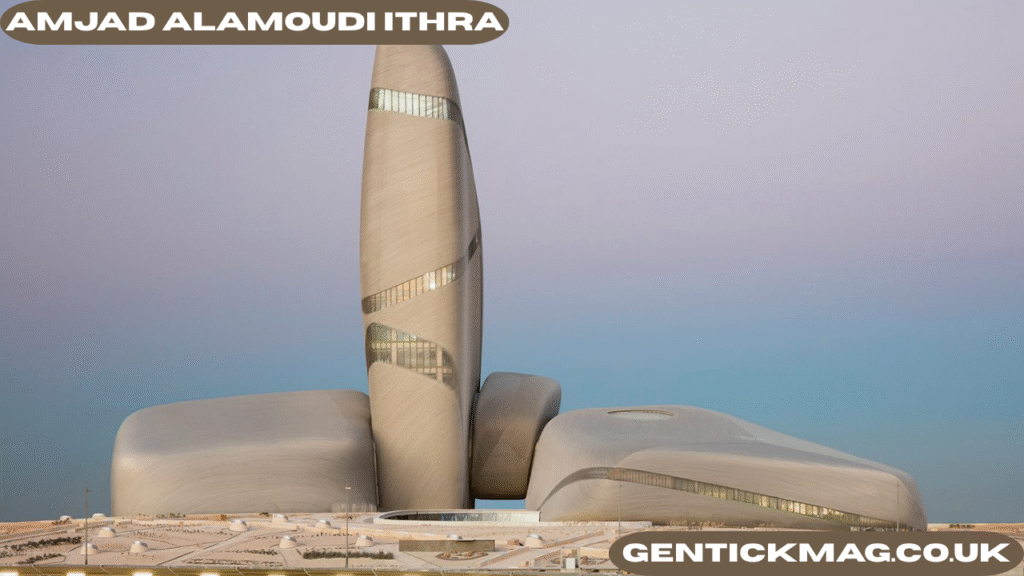Introduction: Who Is Amjad Alamoudi and What Is Ithra?
When we hear the name Amjad Alamoudi Ithra, it sparks interest not only due to the uniqueness of the name but also because it brings attention to one of Saudi Arabia’s most prominent cultural institutions—Ithra, or the King Abdulaziz Center for World Culture. In the context of Saudi Arabia’s Vision 2030 initiative, figures like Amjad Alamoudi play crucial roles in transforming the kingdom’s narrative from an oil-dependent nation to a globally influential cultural powerhouse.
This article dives into the life, career, and cultural influence of Amjad Alamoudi in relation to Ithra, a beacon of creativity, innovation, and cross-cultural dialogue in the Arab world and beyond.
Amjad Alamoudi: A Figure of Cultural Strategy and Innovation

Amjad Alamoudi is often associated with leadership roles that blend creativity with strategic thinking, particularly within institutions that shape Saudi Arabia’s new global identity. While specific public biographical data on him may be limited, his association with Ithra paints a picture of a forward-thinking professional who likely operates in the realm of arts management, cultural diplomacy, or institutional development.
Individuals linked with institutions like Ithra are not merely figureheads—they are visionaries who carry the responsibility of translating national ambitions into experiences that resonate with the global community.
Understanding Ithra: A Jewel in Saudi Arabia’s Cultural Crown

The King Abdulaziz Center for World Culture, known by its Arabic name “Ithra” (which translates to “enrichment”), was built by Saudi Aramco as a symbol of cultural transformation. Located in Dhahran, the center represents a melting pot of art, science, innovation, and history. It serves as a modern-day cultural lighthouse that draws thinkers, artists, performers, and educators from across the globe.
Amjad Alamoudi’s association with Ithra naturally positions him at the forefront of Saudi Arabia’s shift towards cultural modernization and intellectual dialogue.
Amjad Alamoudi Ithra?? Cultural Leadership and Local Impact
A core element in understanding “Amjad Alamoudi Ithra??” is his probable influence on local talent development and cultural programming. Those in leadership roles at institutions like Ithra are responsible for curating events, exhibitions, and talks that bridge the traditional with the contemporary.
Whether overseeing public programming or engaging in strategic partnerships, Amjad Alamoudi likely works toward making Ithra a hub for:
- Cultural education
- Youth engagement
- International collaboration
- Art and design innovation
- Preserving Saudi heritage while embracing global trends
Through this, Amjad Alamoudi Ithra?? becomes a symbol of how individuals can help shape cultural narratives for entire nations.
Vision 2030 and the Ithra Connection
Saudi Arabia’s Vision 2030 initiative is a reform plan aimed at diversifying the economy and elevating sectors like tourism, entertainment, and culture. Ithra is not just a participant but a centerpiece of this movement. With its theaters, libraries, museums, and exhibition halls, it fosters national pride and global connection.
Amjad Alamoudi, within this framework, may be seen as a cultural architect helping to manifest the ideals of Vision 2030. By aligning programming with national goals, he contributes to a new narrative: one where Saudi youth are creators and innovators rather than consumers of foreign culture.
Programs and Projects: The Alamoudi Touch?
While internal records of exact programs led by Amjad Alamoudi are not readily available to the public, one can infer that figures in similar roles at Ithra participate in:
- International art biennales
- Film and media initiatives
- Storytelling and oral history projects
- STEAM education for youth
- Community-based cultural outreach
Amjad Alamoudi’s involvement may be behind programs that emphasize innovation rooted in identity, bringing authenticity to modern Saudi expressions in the arts.
Ithra as a Global Connector: Alamoudi’s Strategic Role
The modern cultural sector isn’t about isolation—it’s about connection. Ithra engages in global exchanges and partnerships with other cultural institutions, museums, and art councils around the world. This is where someone like Amjad Alamoudi plays a vital role. He might serve as a liaison between Saudi heritage and global artistic communities, ensuring that Saudi voices are not only heard but respected on the world stage.
Such responsibilities demand:
- Diplomatic finesse
- Artistic sensibility
- Cross-cultural communication skills
- Strategic foresight
It’s not hard to imagine that Amjad Alamoudi Ithra?? stands at this important intersection of vision and action.
Educating Future Generations: Alamoudi’s Possible Legacy
One of the more enduring aspects of cultural leadership is the impact on youth. Figures tied to Ithra often engage with educational programs that build the next generation of creatives, thinkers, and leaders. If Amjad Alamoudi’s role intersects with educational outreach, then his legacy will likely include:
- Mentorship of young artists and cultural managers
- Development of accessible cultural content
- Collaboration with schools and universities
- Creating platforms for emerging voices
In this way, Amjad Alamoudi Ithra becomes not just a person or a label—but a legacy rooted in cultural transmission and education.
The Symbolism of Amjad Alamoudi Ithra in Contemporary Saudi Identity
The phrase “Amjad Alamoudi Ithra??” captures a profound and symbolic relationship between an individual and an institution. It reflects not only professional alignment but also philosophical synergy.
- Amjad Alamoudi may represent the individual efforts behind cultural advancement.
- Ithra stands for the institutional embodiment of national cultural goals.
Together, they symbolize a new Saudi Arabia—proud of its past, present in its identity, and progressive in its global outlook.
Conclusion: Why “Amjad Alamoudi Ithra??” Matters Today
In a rapidly changing world where cultural heritage is both a marker of identity and a tool for diplomacy, individuals like Amjad Alamoudi are increasingly important. Through Ithra, they influence how Saudi culture is experienced both within the kingdom and internationally.
“Amjad Alamoudi Ithra??” is more than a search query or keyword. It is a reflection of the transformation happening in the Gulf and across the Middle East—one that blends tradition with technology, creativity with structure, and local pride with global ambition.
FAQs on Amjad Alamoudi Ithra
Q1: Who is Amjad Alamoudi?
Amjad Alamoudi is likely a cultural strategist or professional associated with the King Abdulaziz Center for World Culture (Ithra), known for promoting arts, education, and innovation in Saudi Arabia.
Q2: What is Ithra?
Ithra is the King Abdulaziz Center for World Culture, located in Dhahran, Saudi Arabia. It includes museums, libraries, theaters, and galleries, and plays a key role in the nation’s Vision 2030.
Q3: What role might Amjad Alamoudi play at Ithra?
He may be involved in strategic planning, cultural programming, international partnerships, or educational outreach. His exact role might vary but likely contributes to the institution’s cultural influence.
Q4: Why is “Amjad Alamoudi Ithra??” significant?
The phrase symbolizes a synergy between individual leadership and national cultural transformation, especially within the context of Saudi Arabia’s modernization goals.
Q5: How does Ithra connect to Vision 2030?
Ithra embodies the cultural and educational goals of Vision 2030 by offering spaces and programs that encourage innovation, knowledge-sharing, and artistic exploration.
Also read : Nancy Regula, ??—The Life, Art, and Advocacy of a Creative Visionary
